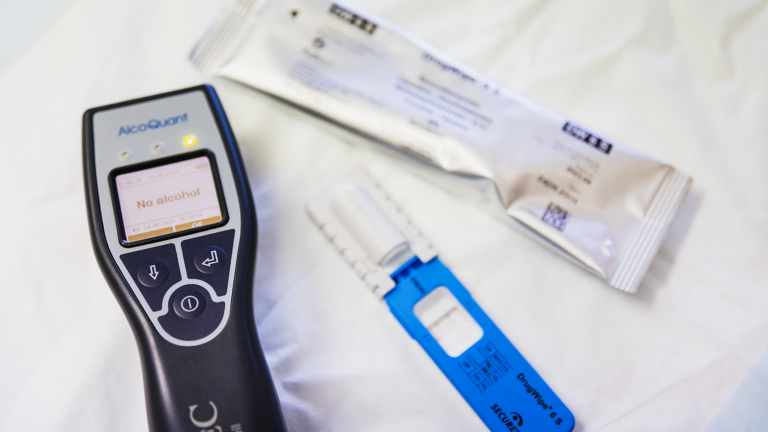Articles
Drug and Alcohol Screening Methods – Pros and Cons of Each

As an employer, you have a responsibility to provide a safe working environment for your employees. Part of that is controlling the presence of drugs and alcohol in the workplace.
That’s why many employers require new hires to submit to drug and alcohol screenings before starting employment. Through proactive screening, companies can reduce risk and prevent injuries before they even have the chance to occur.
Before diving head first into screening and testing, though, it’s important to understand the different screening tools and which are most appropriate for your needs. Each method has its own advantages and disadvantages depending on your industry, processes, and requirements.
There are the most common screening methods and when you might use each.
Urine
Urine sampling is one of the most common and widely used methods of drug and alcohol screening available. The simple collection process and ability for rapid results makes it advantageous.
In a urine drug test, the employee typically reports to a collection location and gives a urine sample. The sample is tested using one of two methods – immunoassay or gas chromatography-mass spectrometry (GC-MS).
Immunoassay testing is often the first step as it can be done quickly and used for mass screenings. This method uses antibodies to detect the presence of specific substances in the urine. However, immunoassay testing is not foolproof and most results are considered presumptive until confirmed.
GC-MS has the ability to detect small quantities of substances and confirm the presence of specific drugs. It is used to confirm or negate any positive results found in the immunoassay. GC-MS results may take weeks to definitively confirm the presence of substances.
Urine sampling is a simple way to test for some of the most common substances, including marijuana, cocaine, opiates, amphetamines, and methamphetamine. It is often a cost effective method of testing and accessible for most workplaces. Initial results can be returned quickly and cut-off levels have been established to help avoid false positives.
However, while a urine screen can test for alcohol, it is not the most effective way to do so, as alcohol passes through the urine rather quickly. Urine screens are also subject to tampering. Since samples are often collected privately, there is the possibility that they could be diluted, switched, or otherwise compromised.
Saliva
Another common method that is even easier than a urine screen is a saliva, or oral fluids, test. This method involves swabbing the inside of the cheek with an absorbent pad which is then tested for substances.
Saliva tests can screen for the substances including marijuana, barbiturates, amphetamines, methamphetamine, and phencyclidine (PCP). Saliva testing can screen for alcohol, though it is not commonly used to do so.
One of the main benefits of saliva testing is the ease with which it is conducted. It is non-invasive for the subject and does not require special facilities as urine testing does. Turnaround times for results are rapid, almost always less than a day.
However, saliva testing is a relatively new method and therefore has less supporting research and documentation. It may also be more difficult to find laboratories that will confirm non-negative results. It can be difficult to detect substances in saliva and subjects may only have to brush their teeth or rinse their mouth before testing to avoid detection.
Blood
Blood tests can also be conducted to identify drugs or alcohol in a person’s bloodstream. Unlike saliva and urine testing which screen for metabolites as substances are broken down, blood testing can detect original drug compounds. This makes it particularly useful for testing immediately after an incident or when impairment is suspected.
A blood sample is taken via a finger prick, from a vein in the arm, or from the back of the hand and sent to a lab for immunoassay testing. This does require trained personnel to collect each sample, making this method less accessible and one of the more expensive screening options. Testing cannot be done on-site and results can take days to weeks to return.
Blood testing can detect common drug substances including marijuana, nicotine, cocaine, opiates, barbiturates, and alcohol. However, time is of the essence. Many of these substances are only present in the blood for minutes to hours.
A large benefit of blood testing is the accuracy. Since the sample is collected by a trained professional, there is little to no opportunity for tampering. Blood cannot be altered or compromised and any positive results are considered definite positives.
Hair
Finally, hair testing can be used to detect drug and alcohol use. Like blood testing, hair tests can detect both drug compounds as well as metabolites. This makes it ideal to understand not only current usage, but chronic usage.
Sampling requires a trained professional in carefully controlled conditions. The collector takes a small amount of hair from close to the scalp and seals it to send to a lab for testing. At the lab, samples are washed to remove contaminants and then tested for substances.
Hair testing can test for the widest range of substances out of any method, including amphetamines, steroids, alcohol, antidepressants, opiates, and more. Substances remain in the hair for much longer than in blood, urine, or saliva, so time is less of a factor in testing. Because collection is done by a professional, it is also one of the most accurate methods with little opportunity for contamination.
Many businesses, though, find this method a poor fit as it is expensive and results can take weeks to return. Testing can show long-term patterns of drug use but cannot pinpoint exact instances of use, nor does it account for any context and cannot indicate current impairment.
Which is best for my business?
Employers may find it difficult to decide which screening method is the best fit for their workplace. The first step is clearly defining how you want screening to be used. You may choose to only screen employees pre-hire. You may continue random testing throughout their employment. You may test when you suspect impairment.
The screening purpose will help you choose a suitable method. For pre-employment testing, most employers elect for urine or saliva testing as it is affordable and can be done in a short time frame.
For random testing throughout your staff’s employment, you may choose saliva since it is easily collected. After an incident, a blood test would likely be your best course of action. You could use just one, or a combination of methods to fit the unique scenario and purpose.
It’s also helpful to look at what you are testing for as some methods are better for specific substances than others. For example, saliva or blood testing would be better to detect barbiturates than urine testing. We recommend testing for the substances that are most pervasive and most harmful in your particular workplace.
If all this information feels overwhelming, don’t worry. An experienced risk management team can help you understand your options and make the best decision for your organisation. If you’re unsure which method is right for you, give Employer Health Solutions a call.
